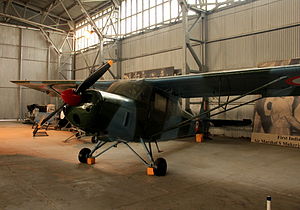| HAOP-27 Krishak | |
|---|---|
 | |
| HAL Krishak, display in Air Force Museum, Palam, New Delhi | |
| Role | Observation aircraft |
| National origin | India |
| Manufacturer | Hindustan Aeronautics |
| First flight | November 1959 |
| Status | Retired |
| Primary user | Indian Army |
| Number built | 70 |
The HAL HAOP-27 Krishak (lit. 'Farmer') [1] was a military observation aircraft produced in India in the 1960s. It was initially developed by Hindustan Aeronautics as an enlarged, four-seat version of the HAL Pushpak light aircraft.
Contents
Two prototypes were built, with the first flying in November 1959 and the second in November 1960. [2] With no interest from buyers, the project was shelved until the Indian Army issued a requirement in the early 1960s for an aircraft to replace the Auster AOP.6 and AOP.9s then serving in the observation role. The original Krishak design was slightly revised to meet the new specification, and the type was adopted into service in 1965. The Krishak was phased out in the mid-1970s when it was replaced by the HAL Cheetah.